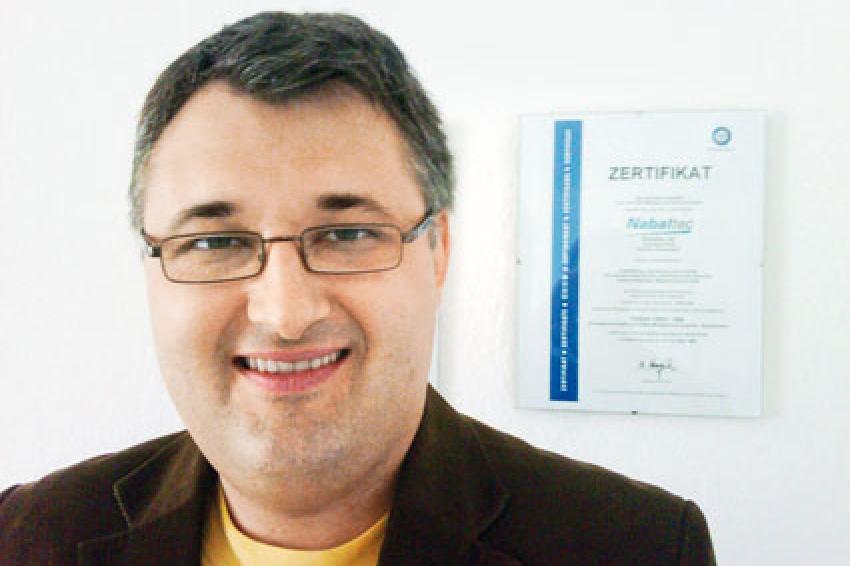Halogen-Free Flame Retardants
Energy-Saving Solutions by Modern Halogen-Free Flame Retardants
Nabaltec produces halogen-free flame retardants for the plastics materials sector. Plastics contribute to the reduction of greenhouse gases with a focus on innovative solutions for protecting the climate and natural resources. With its increase in efficiency, the plastics sector offers solutions for today's challenges. As the plastics industry has put emphasis on climate protection, lightweight construction becomes ever more important replacing conventional metals like steel. The increased use of lightweight constructions is one result of improved flame retardancy, a core competency of Nabaltec. Continued innovations by the Bavarian supplier support plastics manufactures in their developments.
Non-halogenated, flame-retardant fillers are state-of-the-art in many areas of the plastics processing industry. They minimize the risk of fire, increase the escape time by retarding once the surrounding material has caught fire, and reduce the smoke density to enable rescue measures to be performed for a longer time. These flame-retardant fillers are being used in many areas of the plastics industry to satisfy the continuously increasing demands for safety, environmental compatibility and performance, e.g. as regards in thermosetting resins for public transport, the cabling in tunnels or airports, in high-rise buildings, in data processing, in offshore applications and in the insulation industry.
Mineral flame retardants based on metal hydrates, especially aluminium hydroxide (ATH) and magnesium hydroxide (MDH), have established themselves over the years as by far the most important flame retardants. In the past few years, metal hydrates realized the highest growth among all flame retardants. Nabaltec develops, produces and distributes these flame-retardant fillers under the brand name Apyral based on aluminium hydroxide, and under the brand name Apymag based on magnesium hydroxide. These products, which have been optimized for their specific applications, are directly supplied to the plastics industry, and to compounders producing the halogen free flame retardant (HFFR) mixtures. Especially their good environmental compatibility and their favourable price-to-performance ratio make Apyral and Apymag flame retardants with a lasting effect .
In case of fire, these mineral flame retardants decompose by absorbing energy and releasing water, thus absorbing energy which is then no longer available for the prolongation of the fire and diluting fire gases by releasing water vapor. Effectiveness is enhanced as mineral flame retardants create an oxide fire barrier against heat from the flame and prevent burnable polymer decomposition products from reaching the flame.
General advantages of mineral flame retardants are:
- low-cost
- environmentally compatible/
- halogen-free
- retardation of ignition and
- flame propagation
- significant smoke gas suppression
- no volatility (no VOCs)
- no emission of toxic fire gases
- no emission of corrosive fire gases and thus
- reduction of consequential damage
State-of-the-art flame retardants allow a broad application of plastics as substitute for other basic materials, e.g. steel or light metals, and that means saving energy and conserving natural resources.
ATH And MDH for Modern Transport
Mainly fiber reinforced liquid resin parts are used in transport applications in order to increase energy efficiency by managing significant weight reduction. In these applications, good processing properties of the resin mixture is essential. They are used e.g. for the manufacture of components of passenger trains (wagon trim panelling, heads of train) and in boat construction (hulls).
For railway applications comparably high contents of flame retardants are necessary to comply with strict safety standards. Hand lay-up, SMC or pulltruded composites made of appropriate formulations fulfil the main fire retardant standards for railway vehicles and such as German DIN 5510 S4 as well as the French standard NF P 92-501, sometimes toped with a gel coat.
Modern transportation is unthinkable without cables. Cables forward energy and ever growing amounts of data. Thus they are in large numbers installed in vehicles like cars, trains, ships or airplanes.
Cables are installed in large numbers in trains, e.g. for lighting, control panels, for information and convenience in single wagons as well as in the locomotive motor cables, control panels and various cables for communication to the train. Between the single wagons jumper cables guarantee data and energy supply.
It is important to note that in public mass transport systems like trains, ships and airplanes, flame propagation must be slow and smoke development needs to be as low as possible to enable a safe escape scenario. This is also reflected in more severe standards compared to road transport vehicles for fire resistance and low smoke development. Therefore, usually higher amounts of mineral flame retardants are used here, compared to cables for automobiles. A typical ATH content of around 60 wt.‑% leads to improved flame retardancy and reduced smoke density at the same time in HFFR systems.
ATH in Modern Offshore, Wind Park and Solar Application
Requirements on sustainable media resistance and product life time steadily increase. Nabaltec has developed highly sophisticated sub micron grades (Apyral SM / Actilox SM) to enhance flame retardancy and anti-aging effects of compounds. Using these mineral fillers, especially multifunctional elastomeric compounds provide an optimized property profile for specific applications in the transport sector, cable, building, machinery industries and sports areas.
Climate protection requires a quick development of renewable power generation, e.g. the fast growing offshore and marine cable sector need to have a clean and effective fire protection and moreover sustainability of the mechanical properties and a multi years product life time. Environmental influences like see water, temperature and wind mean an enormous challenge. Therefore oil and water resistance are essential compound criteria and need the benefit of mineral flame retardants like submicron ATH or boehmite as well.
Composites performed by modern ATH flame retardants are increasingly used e.g. on a large scale in the field of plant engineering in wind power plants (rotor blades).
One of the fastest growing fields of application for high sophisticated ATH grades is the solar cable sector. Today solar cables are applied in all kinds of climate zones around the globe. The installation of photovoltaic systems requires excellent resistance to UV radiation, temperature and weather changes and e.g. the influence of oil or abrasion. The cable specification requires the use of halogen free materials and must provide moreover low smoke properties and low smoke corrosivity.
High-Temperature HFFR, Environmental Friendly Recycling
Reliability of automotive electronics applied under the hood is one particular example. More compact motor design, weight reduction measures and improved acoustics insulations lead to harder heat conditions.
The use of boehmite grades (Apyral AOH) is gaining major importance as environment-friendly halogen-free flame retardant in polymer applications requiring higher processing temperatures (> 200°C), e.g. printed circuit boards (PCB) and engineering plastics for electrically insulated components. PCB laminates filled with Apyral AOH are technically most advantageous halogen-free products with reliability in the manufacturing process and in the end product, even under a high thermal load.
Environmentally friendly Apyral AOH fillers generate synergistic flame-retarding effects with other halogen-free flame retardants by improving product and recycling properties and offering significant cost cuts.
New Acid Scavenger Enhances PVC Stabilization
The PVC industry has been involved in an active program in recent years to phase out the use of lead stabilizers. Mixed metal stabilizers have been at the forefront of these developments. Actilox CAHC is a purely mineral and eco-friendly calcium aluminum hydrate carbonate. Product, process and application are patented. As acid scavenger it is a key component in heat stabilizers for polymers, especially in heavy metal free stabilizers used in PVC. The availability of Actilox CAHC in large scale enables the PVC industry to speed up the phase out of environmentally critical additives as it was initiated by „Vinyl 2010", the voluntary commitment of the European PVC industry for sustainability.
The users of functional fillers benefit from processing features which also enhance economic efficiency in a sustainable way. Nabaltec offers a wide range of optimized products to help plastic materials to increasingly satisfy higher demands in regard to fire protection, pro-cessability and eco friendliness. They provide the plastic materials with new properties. In this context, one of Nabaltec's strong point is fire protection. Fire protection to saves lives.
Kontakt
Nabaltec AG
Alustr. 50-52
92421 Schwandorf
Deutschland















